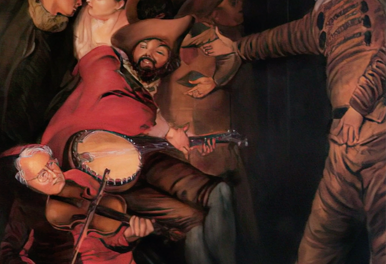
By Marilyn Lester
The Irish Arts Center continues its series of 15 episodes of Mick Moloney’s Songbook, curated by Irish musician, musicologist and teacher Moloney, comprised of stories, songs and tunes from Ireland and Irish America. Moloney, who has a doctorate in Folklore and Folklife from the University of Pennsylvania, explores Irish history and culture through traditional music, thematically contextualizing the meaning of each.
Irish traditional music includes many kinds of songs: ballads, laments, drinking songs, political songs and more, mostly dating from the 18th century to modern times. Their purpose is narrative, with lyric having as much, if not more, weight as the melody. Singers of Irish folk tunes will often use a certain amount of melodic freedom and vocal embellishments to tell the story. It’s a distinctive style, generally communicated with intense feeling to the accompaniment of small groups of musicians playing a variety of traditional instruments.
Episode 4 “Loftus Jones”
From the Celtic origins of the Irish sprang a great tradition of the harp, extending well back into the first millennium AD. The Celtic harp was more than a musical instrument––it was also a literary device, as master players composed songs that ultimately served as a great cultural record. The harp was so important in the history of Ireland that it’s become the national symbol, appearing on coins, the great seal and the pre-tricolor flag. Yet, this great tradition was almost lost under British rule, with the overthrow of the Gaelic order in the 17th century. Fortunately, Belfast musician Edward Bunting (1773–1843) saw the necessity of preserving the harps history, including the 220 works of the blind, itinerant harper, Turlough O’Carolan.
O’Carolan’s “Loftus Jones,” is an instrumental ode to his so-named contemporaneous patron of the harp. Performance is by Moloney on the mandolin, Athena Tergis on violin and Billy McComiskey playing the button accordion. What’s notable about this airy, pleasant tune is that it could almost pass for a movement in a Vivaldi work, but then O’Carolan and Vivaldi were contemporaries, so the influence of one upon the other is no stretch to the imagination.
Episode 5 “Bridget Donoghue”
One of the most colorful of Irish performers was the entertainer and songwriter Johnny Patterson (1840-1889). After a military stint to which he was quite ill-suited, Patterson joined a local circus, where his true talents emerged. He became a stellar singing, dancing, pipe-playing clown with s huge following. His popularity extended to the United States where he spent time touring. It was on such a trip away from home that he wrote “Bridget Donoghue,” a marriage proposal to the lady in question. It’s a remarkably sweet work, played and sung by Moloney on mandolin, with harmony provided by special guest Lucy Johnston—Moloney’s bandmate from the 1960s group the Johnstons, coming out of retirement for a musical reunion 50 years in the making. Haley Richardson plays the violin for this tune and Brenda Castles the concertina and additional vocals.
Episode 6 “Pat Murphy of the Irish Brigade”
Like a hero, he died for the land of the free
Far away from the land of Shillelagh
It’s probably little-known to most Americans, but immigrant Irish “from the land of Shillelagh” played a large role in the American Civil War. Most fought on the Union Side, in a brigade known as “The Fighting 69th.” After the unit was largely decimated at the Battle of Bull Run, survivors and new recruits became “The Irish Brigade.” The lineage of “The Fighting 69th continued, however, into the World Wars. It’s now the designation of The New York National Guard. From its inception, the Brigade’s march was the “Garryowen,” which should be instantly recognizable to anyone who’s attended a New York St. Patrick’s Day parade. (Fun fact: like “The Star Spangled Banner,” the “Garryowen” tune was originally an 18th century drinking song.)
“Pat Murphy of the Irish Brigade” is an anti-war anthem, composed in the narrative style and in contrast to the two prior episodes of this series wherein the songs could be considered quite melodic. Moloney sings to the mandolin and to the violin of Haley Richardson and concertina (and additional vocals) of Brenda Castles.
(Note: we’ll be checking back on Mick Maloney’s Songbook again for the next several installments in the series.)

















